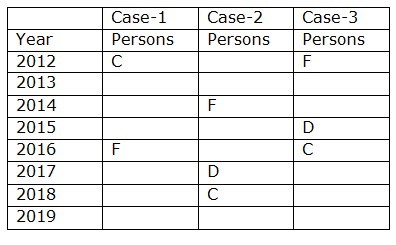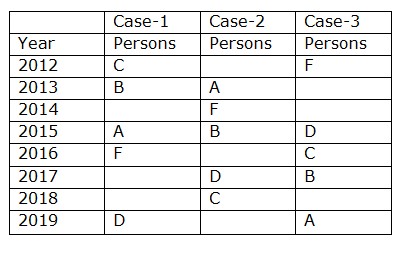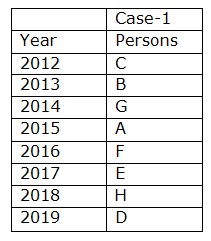Question
Who among the following person completed the training
in 2018? Study the following information carefully and answer the questions given below. Eight persons A, B, C, D, E, F, G and H completed Army training in eight different years viz. 2012 to 2019, but not necessarily in the same order. D completed the training three years after F. Only three persons completed the training between C and F. C doesn’t complete on an odd numbered year. The number of persons completed before D is one more than the number of persons completed after B. Only one person completed the training between B and A. The difference between the years in which G and E completed is three years. Both H and E completed the training in consecutive years.Solution
We have, D completed the training three years after F. Only three persons completed the training between C and F. C doesn’t complete on an odd numbered year. From the above condition, there are three possibilities  Again we have, The number of persons completed before D is one more than the number of persons completed after B. Only one person completed the training between B and A.
Again we have, The number of persons completed before D is one more than the number of persons completed after B. Only one person completed the training between B and A.  Again we have, The difference between the years in which G and E completed is three years. Both H and E completed the training in consecutive years. So Case2 and 3 get eliminated, hence the final arrangement becomes
Again we have, The difference between the years in which G and E completed is three years. Both H and E completed the training in consecutive years. So Case2 and 3 get eliminated, hence the final arrangement becomes 
- A wristwatch was sold for Rs. 720.80, making a gain of 20%. If the selling price had been Rs. 690 instead, what would have been the profit or loss percenta...
- A shopkeeper bought a computer for Rs. 30,000 and a printer for Rs. 5,000. He sold the computer at a profit of 10% and the printer at a loss of 15%. Find t...
A chair listed at 550 is available at successive discounts of 25% and 10%. The selling price of the chair is
- An article has a cost price of Rs. 750 and is marked 40% above its cost price. 'A' proposes to sell this article after two successive discounts of 12% and ...
- A seller sold a product for Rs. 1152 after giving two identical discounts of x% each on the marked price of Rs. 1800. What is the value of x?
- The marked price of an article is 150 percent of its cost price. If 25% discount is given at the time of selling the article, then what will be the profit ...
Rahul sold a computer after giving a discount of 10% and earned a profit of Rs. 1200. If he had sold it for Rs. 300 less, he would have earned a profit ...
A shopkeeper marks the price of the article in such a way that after allowing 28% discount, he wants a gain of 12%. If the marked price is ₹224. then ...
Sara sold 30 scarves at a profit of 25%. If she had sold all the scarves for Rs. 3000 more, her overall profit would have been 50%. What is the selling ...
The purchasing price of 275 articles is equal to the selling price of 250 articles. Find the profit/loss%.
Relevant for Exams:


